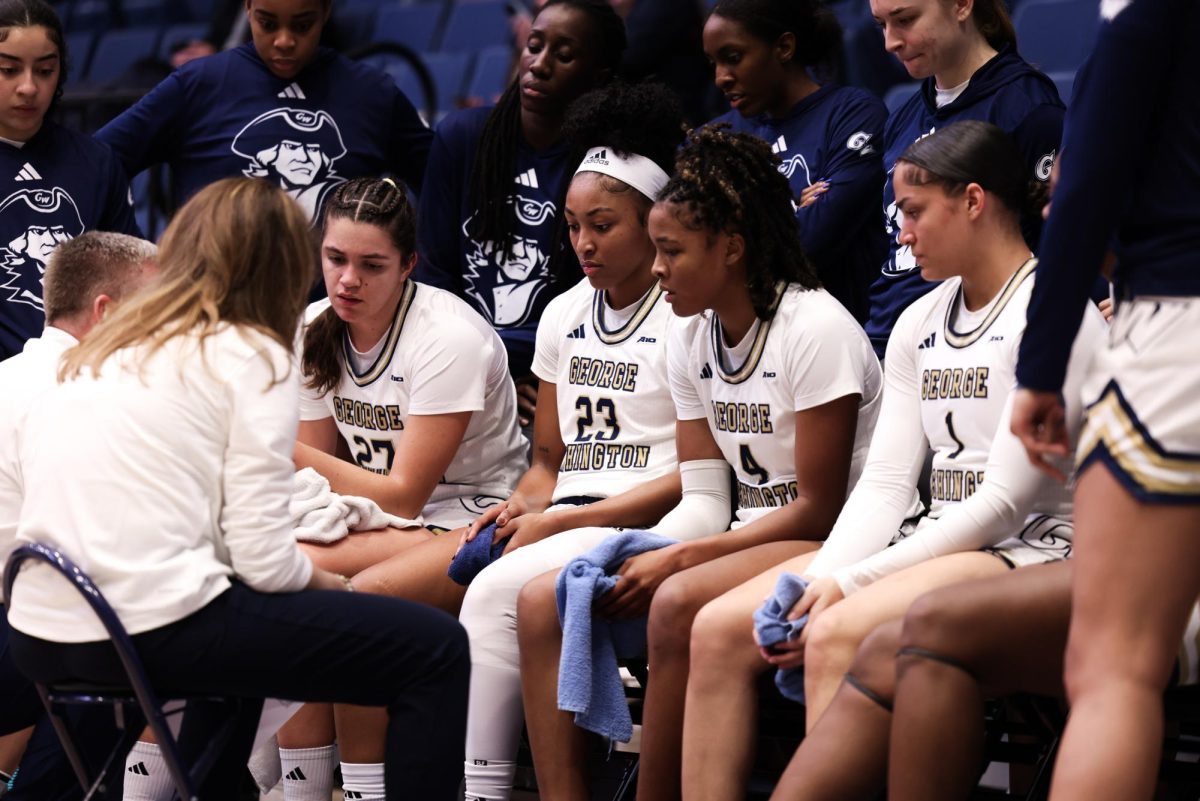Synchronized skating, or “synchro,” is a branch of figure skating that is still new and unfamiliar to the general public. In 2002, several area universities established the Pentagon Intercollegiate Synchronized Skating Team, but it has not helped to promote awareness of the sport.
“Most people have never even heard of synchronized skating,” freshman Erin Shea said. “When someone asks me to describe it, I tell them that it is just like synchronized swimming, if the pool froze over.”
Shea is one of three GW students to participate on this D.C./Maryland synchro team, the first intercollegiate synchronized skating team in the United States. They compete and practice with girls from Georgetown, Catholic and Johns Hopkins universities, Notre Dame of Baltimore and the University of Maryland. Competitions are co-ed, though the team is currently comprised only of women.
Synchronized skating teams are comprised of 12-24 participants who skate simultaneously. They perform a series of coordinated maneuvers and formations, executing individual stunts while remaining in step with teammates. The most common formations are lines, circles, blocks, wheels, and “V’s,” which skaters intersect and transition between, while performing simple spins and jumps. There are more than 20 collegiate synchronized skating teams in the U.S., most of which have grown rapidly in recent years.
“Last year was our growing year,” Georgetown sophomore and coach Brienne Johnson said. “It was a big challenge, because we had girls of every skill level – some had been skating for years, while others had never set foot on the ice. This year, we have a much stronger team, but we still have a very broad range of ability.”
Last month, Johnson’s team competed in the Eastern Sectionals in Providence, Rhode Island, and qualified to compete in the National Collegiate Synchronized Skating Competition in San Diego, California on Thursday. Although they are excited and proud, they said they have also been working hard to raise enough money to make the trip.
It has been difficult for the team to defray the considerable costs that accompany synchronized skating. They can only practice once a week because it costs $265 per hour to rent ice time, and the dispersion of rival teams makes it harder to travel to competitions. Participants must pay approximately $100 per month each for the 6-7 months of their season. Since this does not come close to covering all costs, the team fundraises, aiming to amass an additional $700.
“Synchronized skating is an expensive sport, and it’s an extra challenge to get funding for our team from any one university,” Johnson said. “We have to pull from several resources to pay for everything, but mostly from the girls’ monthly dues.”
Individual dues are “much higher than the girls would prefer,” but they have managed to attract various individual sponsors, including parents, family, and previous instructors, to help with expenses. The Hayden Skating League loans them competition dresses, which would otherwise cost between $300 and $400 per garment. The University of Maryland has also contributed to the teams’ funds; however other participating universities, including GW, have not.
GW freshman and synchronized skater Christine Burke recently established a figure skating club at GW called the “G-Dub Gliders.” Currently, the club has eight members, and Burke hopes to attract more students during spring and fall recruitment.
“It’s still in its very early stages right now, but I’m sure that there are more figure skaters at GW who don’t even know that this opportunity exists,” Burke said.
Johnson has encouraged members from other universities to create similar clubs in effort to boost funding and attract participants for both individual and synchro competitions.
“We’re hoping to synthesize university teams so that they and the synchronized team support one another,” Johnson said.
Most members of the synchro team have some background in figure skating, but many are just learning to skate as a team. While individual competitions focus on jumps and other complicated maneuvers, synchronized skating emphasizes rhythm and harmony between skaters and requires fewer intricate stunts.
“The transition was difficult,” said Shea, who is also a Hatchet photographer. “There’s more pressure in synchro, because if I mess up, it messes up the whole team.”
Both Johnson and Burke have a strong background in synchronized skating, and Johnson’s former team, the Heydenettes, has been ranked fourth in the world and is in contention to compete in the 2008 Olympic Games. While Johnson enjoys her coaching duties, she hopes to compete with them in the Olympics if they are selected.
“She’s a great leader, with a lot of experience,” Burke said of Johnson. “She’s so put together and mature that we joke around and say she has a husband and four kids stashed away somewhere.”






